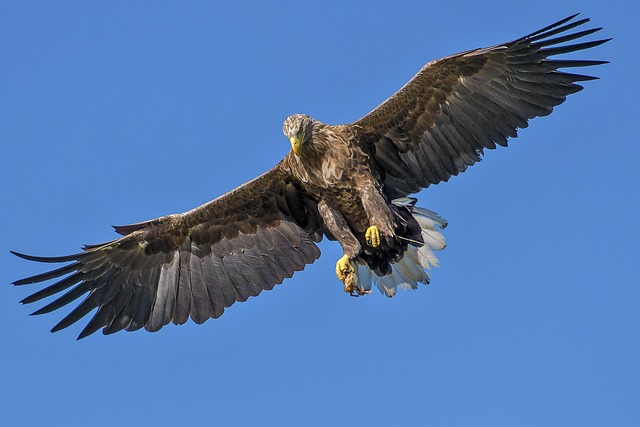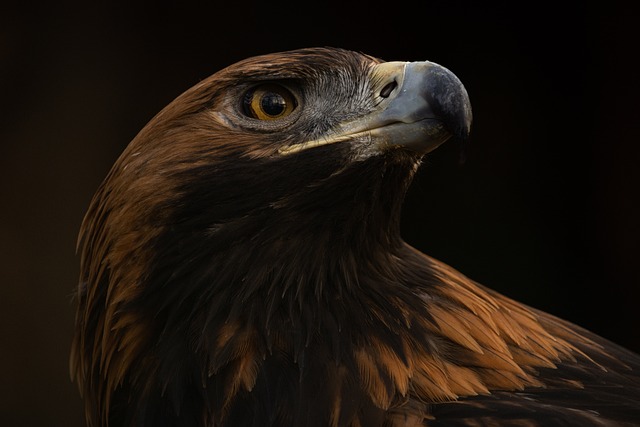The golden eagle (Aquila chrysaetos) is one of the most renowned and widespread birds of prey in the Northern Hemisphere. Known for its majestic appearance and remarkable hunting skills, this species is often regarded as a symbol of power and freedom. Below is a detailed overview of the golden eagle:

Physical Description
Golden eagles are large birds of prey with powerful builds:
- Size: They typically measure 66–102 cm (26–40 inches) in length with a wingspan of 180–234 cm (71–92 inches).
- Weight: They weigh between 3.6–6.6 kg (8–15 lbs), with females generally larger than males.
- Plumage: Their plumage is dark brown with a golden sheen on the back of their heads and necks, giving them their name.
- Beak and Talons: They have a hooked beak and sharp talons, designed for capturing and tearing prey.
- Eyes: Their keen eyesight allows them to spot prey from great distances.
Habitat and Distribution
Golden eagles inhabit a wide range of environments:
- Range: Found throughout the Northern Hemisphere, including North America, Europe, Asia, and parts of North Africa.
- Preferred Habitats: They thrive in open and semi-open habitats like mountains, grasslands, steppes, and deserts. They avoid densely forested areas and urban environments.
- Nesting Sites: Nests, called eyries, are often built on cliffs or tall trees, providing a vantage point and protection from predators.
Diet and Hunting Behavior
Golden eagles are carnivorous, known for their exceptional hunting skills:
- Primary Diet: They primarily prey on small to medium-sized mammals, such as rabbits, hares, ground squirrels, and marmots.
- Occasional Prey: They may also hunt larger animals like foxes, young deer, and lambs or feed on carrion.
- Hunting Techniques: Golden eagles use their powerful wings for soaring at great heights and their sharp talons to grab and subdue prey. They can dive at speeds exceeding 240 km/h (150 mph).
Behavior and Social Structure
- Territoriality: Golden eagles are territorial and often defend large areas from intruders.
- Mating: They are monogamous and may pair for life. Mated pairs often perform aerial courtship displays, including spirals and dives.
- Communication: They communicate through vocalizations and body language, although they are generally silent outside of breeding season.
Reproduction
- Breeding Season: The breeding season varies by region but generally occurs in spring.
- Eggs: Females lay 1–4 eggs per clutch, with an incubation period of 41–45 days.
- Parental Care: Both parents participate in rearing, but the female spends more time brooding while the male hunts.
- Fledging: Chicks fledge at about 65–80 days but remain dependent on their parents for several months.
Lifespan
- In the Wild: Golden eagles typically live 15–20 years in the wild.
- In Captivity: With proper care, they can live up to 30 years or more.
Cultural Significance
- Symbolism: Golden eagles are revered in many cultures, symbolizing strength, courage, and freedom. They appear in heraldry, folklore, and as national emblems (e.g., the national bird of Kazakhstan and a symbol in Native American cultures).
- Falconry: They have been used in falconry, particularly in Central Asia, where they are trained to hunt large prey like wolves.
Conservation Status
- IUCN Status: Least Concern.
- Threats: Habitat loss, hunting, poisoning, and collisions with wind turbines pose risks to certain populations.
- Protection Efforts: Conservation measures include habitat preservation, regulations against hunting, and educational programs.

The golden eagle stands as a testament to nature’s beauty and the intricate balance of ecosystems. Its adaptability and prowess continue to inspire awe and respect among wildlife enthusiasts and researchers alike.

